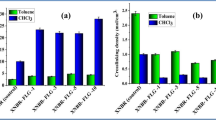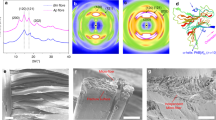Abstract
CURRENT commercial methods for converting polyacrylonitrile based textile fibre to high elastic modulus carbon fibre usually1 but not essentially2 involve a first stage of heating to a temperature between 200 and 300° C in air. During this so-called preoxidation stage, a proportion of oxygen is taken into the modified polymer structure to produce a black, heat resistant fibre3.
This is a preview of subscription content, access via your institution
Access options
Subscribe to this journal
Receive 51 print issues and online access
$199.00 per year
only $3.90 per issue
Buy this article
- Purchase on Springer Link
- Instant access to full article PDF
Prices may be subject to local taxes which are calculated during checkout
Similar content being viewed by others
References
Shindo, A., Rep. Gov. Ind. Res. Inst., Osaka, Japan, No. 317, December 1961.
Standage, A. E., and Prescott, R., Nature, 211, 169 (1966).
Houtz, R. C., Textile Research J., 20, 786 (1950).
Total Spectra Chemical Classes Index, Sadtler Research Laboratories Inc., Philadelphia, Pa., USA.
Author information
Authors and Affiliations
Rights and permissions
About this article
Cite this article
STANDAGE, A., MATKOWSKY, R. Structure of Oxidized Polyacrylonitrile. Nature 224, 688–689 (1969). https://doi.org/10.1038/224688a0
Received:
Issue Date:
DOI: https://doi.org/10.1038/224688a0
This article is cited by
-
Mechanism of oxidisation of polyacrylonitrile fibres
Nature (1975)
-
Carbon Fibre Formation—the Oxidation Treatment
Nature (1971)
-
Low Pressure Pyrolysis of Polyacrylonitrile
Nature Physical Science (1971)
Comments
By submitting a comment you agree to abide by our Terms and Community Guidelines. If you find something abusive or that does not comply with our terms or guidelines please flag it as inappropriate.



